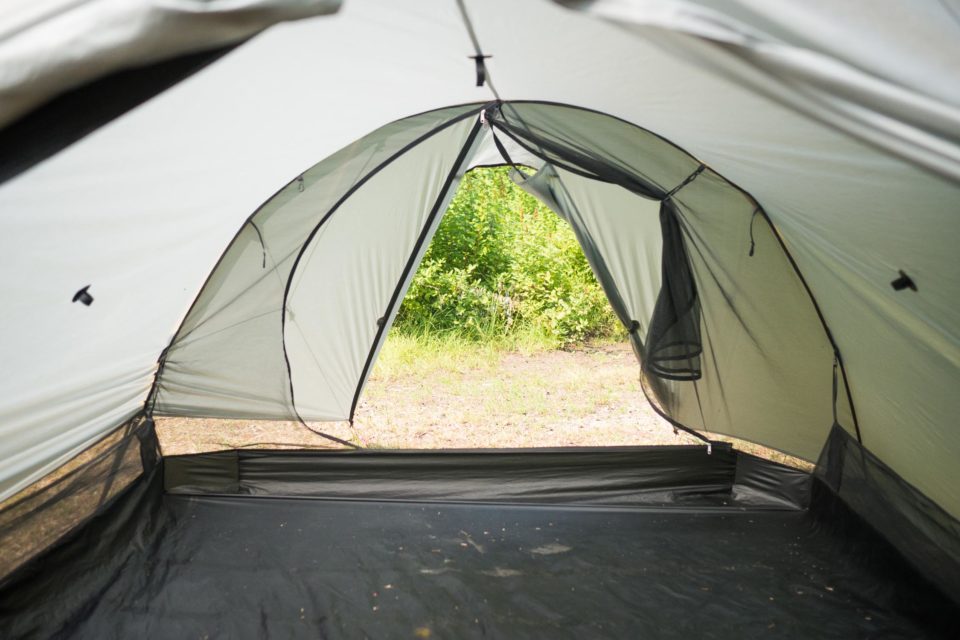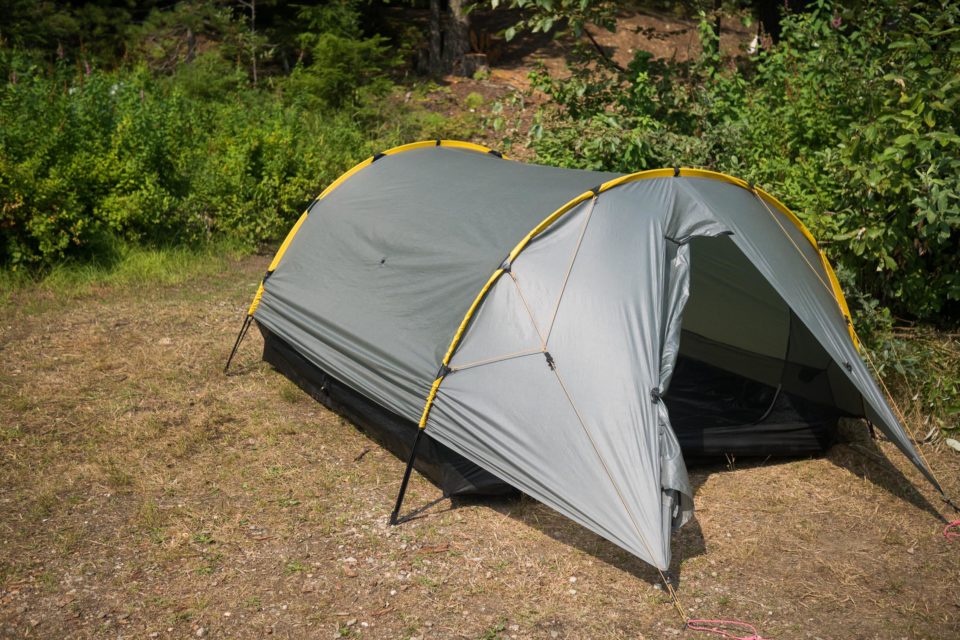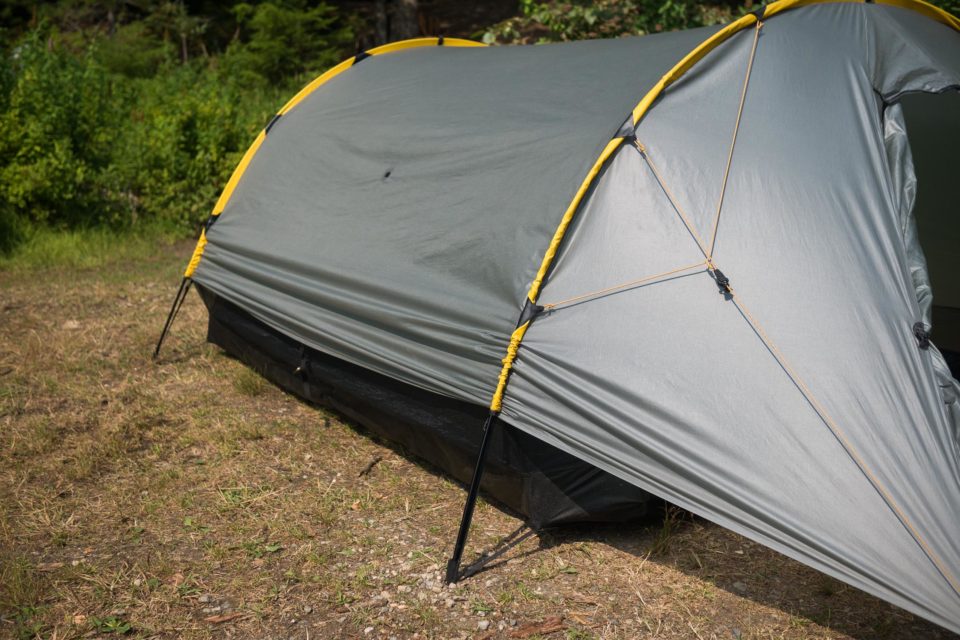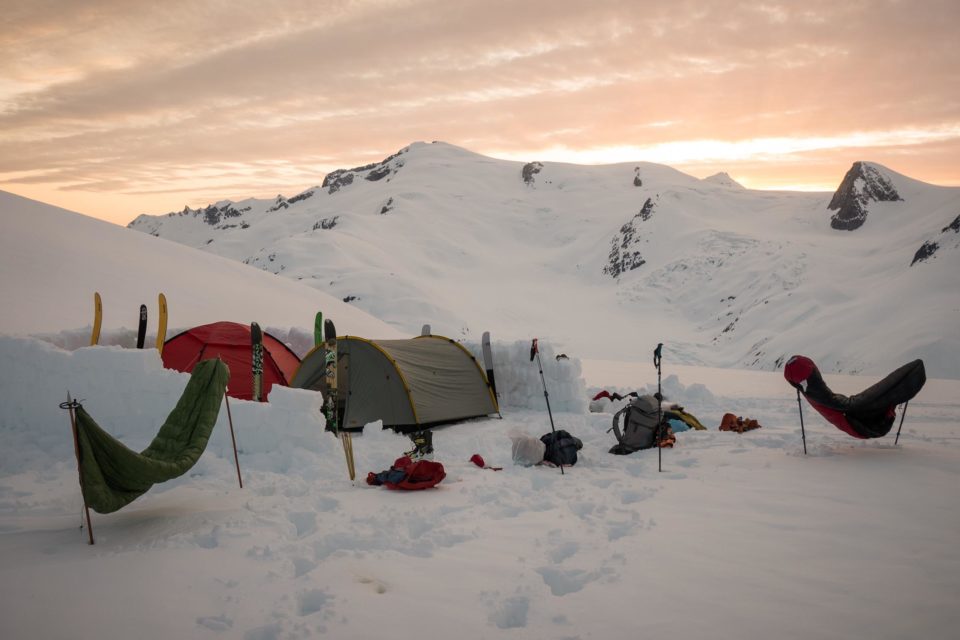Tarptent Cloudburst 3 Review
“It’s not you, it’s the tent.” Most of us will agree, bikepacking as a couple is best done with a three-person tent. After 11 years, Skyler finds his ideal couples bikepacking shelter in a unique tunnel tent design, the Tarptent Cloudburst 3. Read the full review…
It took a few longer trips for us to agree: “It’s not you, it’s the tent.” My partner and I love each other very much and we especially wish to continue loving each other. For this reason, we’ve come to the conclusion that we can’t travel for more than a few nights together while sharing a 50” wide two-person tent.
The second tent we purchased together was marketed at an ultralight “Two+”, with a floor width that tapered from 59” at the head to 51” at the feet. This became another lesson in tent selection: humans do not occupy an area, they occupy a volume. While the floor space may indeed have been wider than the standard 50” two-person width, the walls sloped and sagged inward so claustrophobically that changing in that tent required contortionist manoeuvres. Or, lacking yogi flexibility, it involved elbowing each other in the neck while tempers boiled.

When Tarptent reached out to ask if we’d like to review one of their, I enthusiastically asked if I could test what was at the time, their only three-person offering, the Cloudburst 3 (they’ve recently added a second three-person shelter, the Rainshadow 3). Accustomed to their typical clientele of thru-hikers, who seem willing to forgo any amount of “livability” to hit a lower pack weight, they replied to ask why we wanted one of their largest models. For one, cyclists don’t use trekking poles, so tents designed around trekking poles don’t offer the same appeal to us. Second, I’ve found that the trade-off of comfort to weight is a little different when the weight is on a bike versus on your back.
While it’s far from the lightest choice for a couple, and it might fail to earn that “ultralight” moniker, the Cloudburst is still light at 1.5kg all-in. Compare that to the types of shelters coveted by thru-hikers, $600-$1000 dyneema things, and it won’t seem impressive. But compared to typical high-end backpacking tent from bigger companies like Marmot, MSR, or Sierra Designs, Tarptent’s Cloudburst 3 looks like a light two-person shelter by weight. In fact, I don’t know of a tent that does better on a ratio of weight to livable space. And, Tarptent achieves this weight using 30D silicone-coated nylons instead of the much thinner, fragile 15D and 7D fabrics employed by Big Agnes and MSR, for example. As such, we’ve felt confident using the Cloudburst 3 without a ground sheet, and it has yet to show any sign of wear.

The Cloudburst 3 is a hybrid single-wall tunnel tent with a vestibule at either end. Hybrid single-wall construction means the overhead tunnel of the tent consists of just one layer, while there is a layer of bug mesh separating the sleeping area from the vestibules, in addition to the silnylon tent fabric at either end. Single-wall overhead, double-wall at the ends.
Additionally, along both side of the tent, the bathtub floor is separated by a perimeter of mesh, making it nearly impossible to touch the main wall of the tent while sleeping, or for condensation to drip into the bathtub floor area.
Specs
- Sleeps: 3
- Seasons: 3+
- Weight: 52 oz / 1.5 kg
- Interior Height: 40 in / 102 cm
- Floor width: 62 in / 157 cm
- Floor length: 86 in / 218 cm
- Stakes: 4 x 6 in / 15 cm Easton Nanos (included)
- Packed size: 20 in x 4 in / 51 cm x 10 cm (official) 10” x 6” (tested)
- Price: $369USD
Note: The tent fabrics used by Tarptent cannot be seam taped. As such, the main seams must be seam-sealed using a brush-on seam sealer. Tarptent offers this service for $35 extra (which is worth it!) or you can do it yourself with an $8 kit. Tent weight includes stakes, guylines, stuffsacks, and arch poles.
Our first time in the tent, it was obvious that it solved many of the issues that infuriated us about our previous tents. Inside, it is absolutely cavernous. In addition to its impressive floor area, the walls at each end are plumb vertical, which makes it possible to comfortably sit up mere inches from the door. The side walls are also steep, thanks to the semi-cylindrical tunnel shape, making it comfortable for multiple people to lounge or change clothes in the tent simultaneously.
We’ve used the Cloudburst with three people for about 10 nights, and even if the floor space is only just wide enough for three 20” sleeping pads, the internal volume makes it reasonable for three people to move around in the tent. Due to the width, sleeping as three people is only comfortable oriented head-to-foot, which can make it more difficult to find a suitably flat tent site.

Tunnel Tent
Many people will rank “free-standing” among the positive traits of a tent, and non-free-standing as a drawback. My experience has slowly taught me the opposite. The tunnel design of the Cloudburst 3 is, of course, not free-standing. The two aluminum poles create arches that hold the tunnel apart, while tension from two stakes at each end is what keeps the the tent upright. The simple tensioned structure is inherently sturdy against wind, all while using half as many stakes, and taking less than half as long to set up as most lightweight free-standing tents. The result is a semi-cylinder that is taught throughout, without sags or droops. Nylon, of course, stretches a bit when it cools down or gets wet, but it’s just a matter of tightening a couple cord-locks to return the Cloudburst to a graceful tube.
Whereas our old “free-standing” tent required 11 stakes, several minutes of setup and adjustment, and ideally a couple of branches or bikes to achieve an acceptable pitch, the Tarptent takes mere seconds to erect. I carried extra stakes for our first few outings, but eventually gave up trying to find uses for them. It really only needs four stakes. The Easton Nano stakes that were included with the tent, however, are not up to the rigors of rocky ground. I broke two in short order before switching them out for ever-reliable DAC J-stakes.
I suspect the main concern people have with non-freestanding tents has to do with pitching the tent on bedrock or other surfaces that won’t hold a stake. Employing a bit of extra cord, I’ve found it easy and effective to pitch the Cloudburst 3 by slinging rocks, sticks, and even on snow using skis.
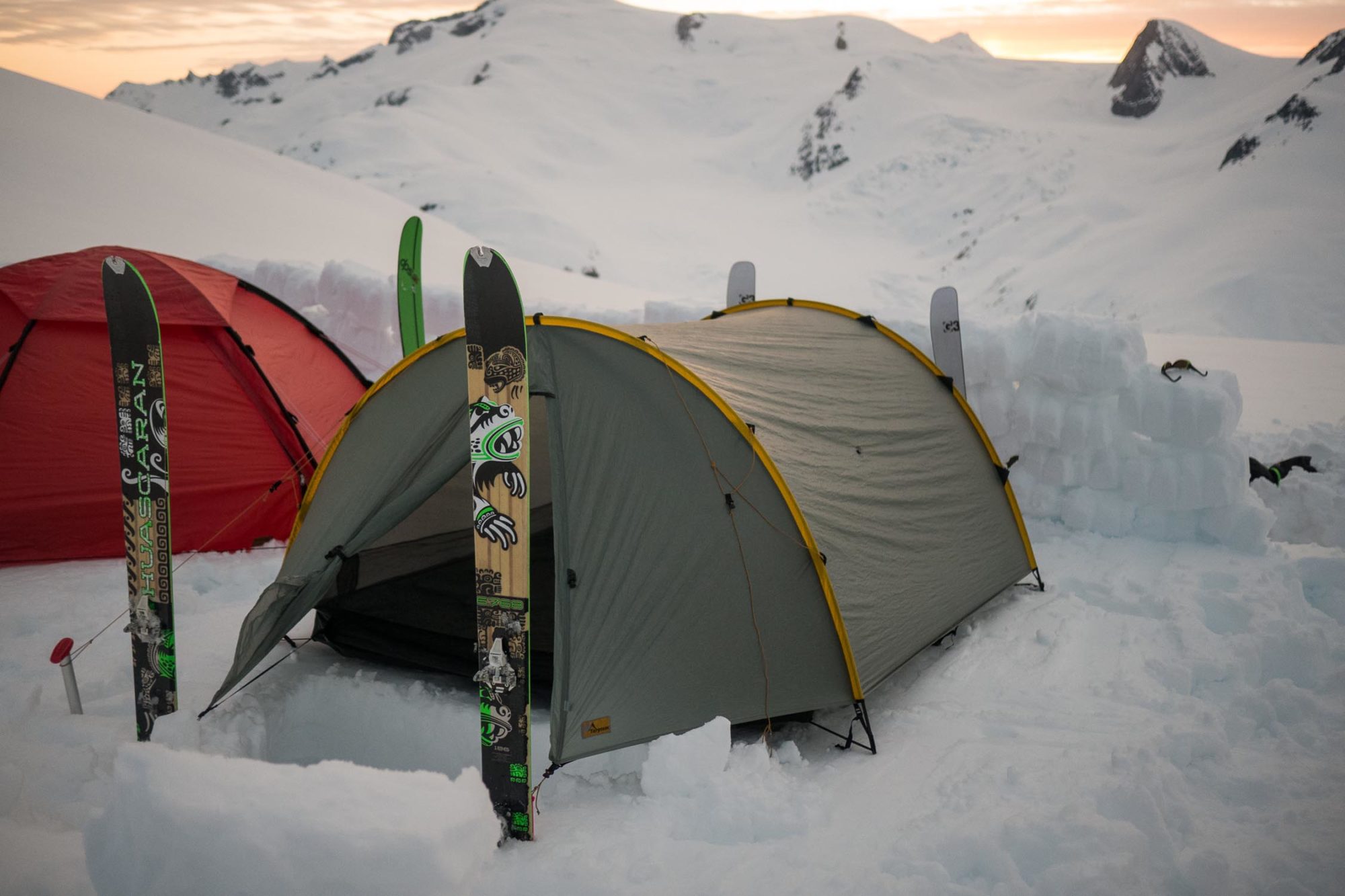
Managing Condensation
My main concern with the Cloudburst 3 was whether the single-wall construction would lead to issues with condensation. In the absence of precipitation, Tarptent’s brilliantly simple design allows for impressive ventilation that effectively negates any concerns about condensation. In hot weather, the vestibules can be completely rolled up and secured so that either end of the tent is is a window of mesh. Even in rain, the doors can be stowed open without rain falling onto the inner mesh doors. Along both sides of the tent, the outer wall can be tensioned down to the ground in nasty weather, or scootched up along the poles allowing 8-10” high mesh windows along the length of the tent. With the sides pulled up and the vestibules stashed, you can have 360 degree views and ventilation in mild weather.
Of course, condensation is rarely a concern in such mild weather. The bigger concern is hours of rain in a saturated atmosphere. I’ve been lucky to have only experienced these sorts of conditions on two or three nights, but we found it manageable. Condensation did indeed collect on the inside of the roof. But, any drops that grew enough to move would slide down the wall, through the mesh, and out of the tent. Since the bathtub floor is set in from the wall, and there’s so much moving space inside the tent, it’s easy to avoid touching the wet walls. That is, with two people. With three inside, it would be much harder to avoid touching the wet ceiling/walls.
Only once did a few drops land on us. A full night of rain in 100% humidity left the skin of the tent soaked inside and out. Across the middle of the tent, there are three small velcro straps that allow a third pole to be added for use during extreme winds. These velcro pieces made drip points on either wall that allowed a small number of drops to fall on us in the night. Similarly, I imagine a sudden gust of wind might have unleashed some of the ceiling’s many drops onto us, though we never did encounter this situation.

Multiple days of heavy rain in a row may pose a more serious problem. Since the Cloudburst 3 is one piece, as opposed to a separate inner tent and fly, when you pack it up wet, all parts of it tend to end up wet. The following evening, if it’s still raining hard, the now-wet floor may not dry before bedtime. This is likely the main downside of a single-wall tent.
All that said, in all of our bikepacking trips with this tent, we’ve not yet experience the combination of weather that might make us unhappy to be in a single-wall tent. We’ve learned a few tricks that, combined with the Cloudburst’s excellent ventilation, have mostly eliminated condensation from our nights. For one, we try not to camp in the cold-air drainage that flows alongside creeks. On clear nights when we sense that there will be a heavy dew, we also seek camp spots under a closed tree canopy, and often wake up in a totally dry tent to find soaked grass in all the openings.
For people planning a trip in particularly wet climates, such as Chilean Patagonia, there’s an optional condensation liner that adds a second wall across the ceiling of the tent. Similarly, for those planning a trip somewhere very windy, it is possible to add a third pole at the middle of the tent.
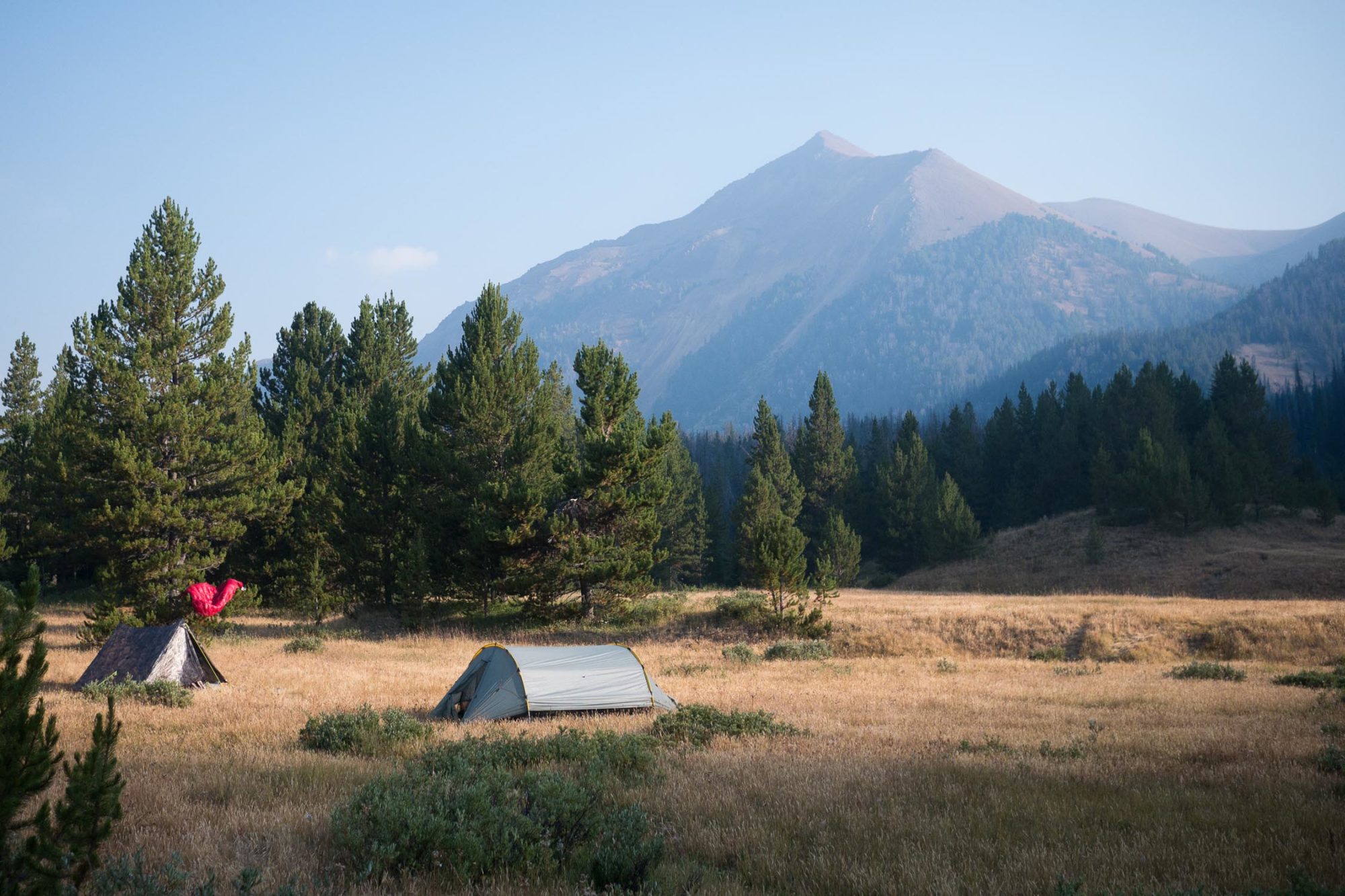
Pros
- Unbeatable space to weight
- Super comfortable for sanity on long trips
- Still very lightweight
- Good in wind
- No pole hubs, so poles pack into a very compact package
- Truly only requires four stakes
- Extremely fast to set up and take down (stuffable)
- Significantly lower price than competition
- Made in Seattle, USA
Cons
- Single-wall construction requires care for condensation management
- The cord loops for staking out the tent sometimes feel annoyingly short, I had to add some extra cord
- Must be seam sealed
- Easton Nano stakes broke very quickly
- Not an ideal choice for your first tent – the Cloudburst is not forgiving of user error, and like any ultralight product, benefits from strategic handling
Wrap Up
If you can’t tell, I love this tent. I used to be the guy who’d go on tirades about tents designed by people who live in places with no rain, and how tent design was all about marketing bullet points (free-standing, double-wall, ultralight) with no thought given to actually living inside them. Since I wore out a now-forgotten MSR single wall tent in about 2007 (the MSR Fling), I haven’t had much nice to say about any tent I’ve owned. Now, after 11 years, I have found another tent I love, and it’s even better than the first one. The Cloudburst 3 is exceptional. It has all the features I’ve come to value, and none of the ones that don’t add much. Like any super pared-down ultralight product, the Cloudburst is probably not an ideal choice for your first tent. While it performs wonderfully with a bit of forethought and gentleness, it’s much less forgiving of user error than a double-wall, free-standing tent.
Please keep the conversation civil, constructive, and inclusive, or your comment will be removed.








